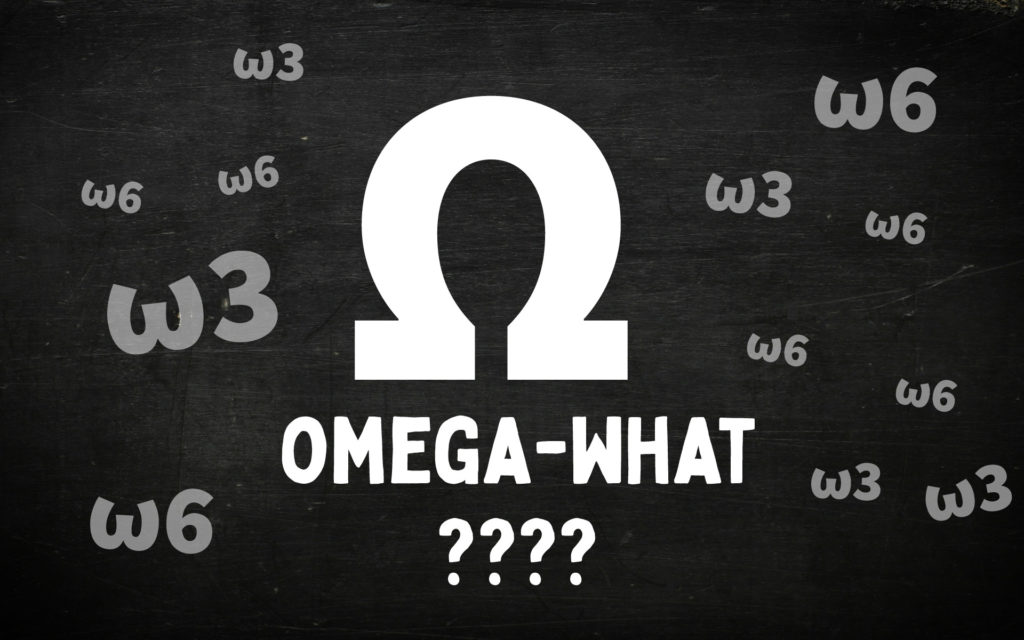The Omegas: benefits and virtues
Reading time: 3 minutes | Written with love by: Alexis
Omegas play an essential role in our metabolism. Want to know more ? Alexis tells you all about it!

What are the omegas?
The omegas are a group of fatty acids with a carbon chain ending in a carboxyl group (-COOH). This carbon chain can be:
- either devoid of double bonds: the fatty acids are said to be saturated
- or have one or more double bond(s): in this case, the fatty acids are said to be mono or polyunsaturated.
While saturated, monounsaturated and some polyunsaturated fatty acids can be synthesised by the body, polyunsaturated fatty acids of the omega-6 and omega-3 family, namely linoleic and alpha-linolenic acids, must be provided by the diet.
For unsaturated fatty acids, they are referenced depending on the first double bond. Thus, the fatty acids of the omega 6 (n-6 or ω 6) and omega 3 (n-3 or ω 3) families have the characteristic of having their first double bond located respectively at 6 carbons (n-6) and 3 carbons (n-3) from the methyl end (the beginning of the molecule).
These two double bonds cannot be modified by human or animal. However, they are able to add to these two precursor fatty acids (linoleic acid C18:2 n-6 and alpha-linoleic acid C18:3 n-3) additional double bonds, towards the carboxyl end (the other end of the molecule), and lengthen the chain at this end.
All the derivatives obtained, added to the two essential fatty acid precursors, constitute the two families of essential fatty acids, necessary for the maintenance of biochemical, cellular or physiological functions.
The benefits of precursor omegas
Alpha-linolenic acid (ω 3) and linoleic acid (ω 6) contribute to maintaining normal cholesterol levels.
From ω 3, we can make some (unfortunately very low conversion rate) alpha-linolenic docosahexaenoic acid (DHA) which contributes to normal brain function.
The benefits of essential fatty acids are therefore numerous.
Dietary Sources of Omegas
Linoleic and alpha-linolenic acids are present in vegetable oils: sunflower and corn for linoleic acid and rapeseed and soya for alpha-linolenic acid.
Long-chain polyunsaturated fatty acids (LC-PUFAs) of the omega-6 family are also provided by the consumption of land animal products (meat, eggs) and breast milk.
LC-PUFAs of the omega-3 family are provided by fish and other marine animal products and breast milk.
Minimum recommended intake for Omega 3
There is currently no NRV for Omega 3 in the UK, but the EFSA (European Food Safety Authority) recommends a minimum of 250 mg per day of omega 3 for adults and children over 2, plus an extra 100 mg for pregnant and lactating women.
The Omega 3/Omega 6 balance
Omega 6 fatty acids can cause excessive competition with the absorption of omega 3 fatty acids.
The ratio between omega 6 (linoleic acid) and omega 3 (alpha-linolenic acid) should be 4:1, whereas it is currently much higher1 . This excess of omega 6 hinders the optimal use of omega 3 by the body and therefore their benefits.
1: Kris-Ethertob PM et al. Fish consumption, fish oil, omega-3 fatty acids, and cardiovascular disease. Circulation, 2020 Nov19;106(21):2747-57
TOP 5 foods containing Omega-3
- Cod liver oil
- Fish (mackerel – salmon)
- Vegetable oil
- Nuts
- Flax or chia seeds
So what are chia seeds?
A little history lesson
Chia (pronounced tchia!) is a plant that historically comes from the subtropical regions of South America. Chia seeds were a mainstay of the diet of pre-Columbian civilizations. They called it the “seed of the gods” because of its many virtues. It was a favourite food of hunters and warriors when they travelled.
Where do the Bio Frères chia seeds come from?
Until now, chia seeds were mainly imported from South America because they could not be cultivated in our climate.
In fact, chia is originally a tropical plant and needs an adapted photoperiod to grow in our region. This unfortunately implies a considerable carbon footprint, as we need to transport the chia to France!
But don’t worry, the Bio Frères have joined the new French chia sector.
It is the ORURO® variety, a non-GMO variety obtained by natural selection and which is adapted to cultivation in the temperate climate of French regions. French producers have organised themselves into a new ‘Chia de France’ network to exchange good cultivation techniques and improve production.
All about the chia culture in France
Plant-based OMG3 from the Bio Frères from the Chia seed

We have designed for you an organic and eco-friendly vegan food supplement based on chia oil, rich in Omega 3.
Chia is a plant from Central America and Mexico, whose name means “strength” in Mayan. The first cold pressing of the seed releases a vegetable oil reputed to be the richest in Omega 3!
At the current time, the balance between omega 3 and omega 6 is not at all respected, our consumption is far too rich in omega 6!
Chia oil can therefore help to restore the balance and so combat various problems linked to this dietary imbalance.
Order OMG3 from the Bio Frères
Written with love by: Alexis
Alexis is a researcher. True guardian of the temple, he ensures the effectiveness of formulas, compliance and product certifications. He also manages our scientific monitoring and the in-depth articles on our blog.